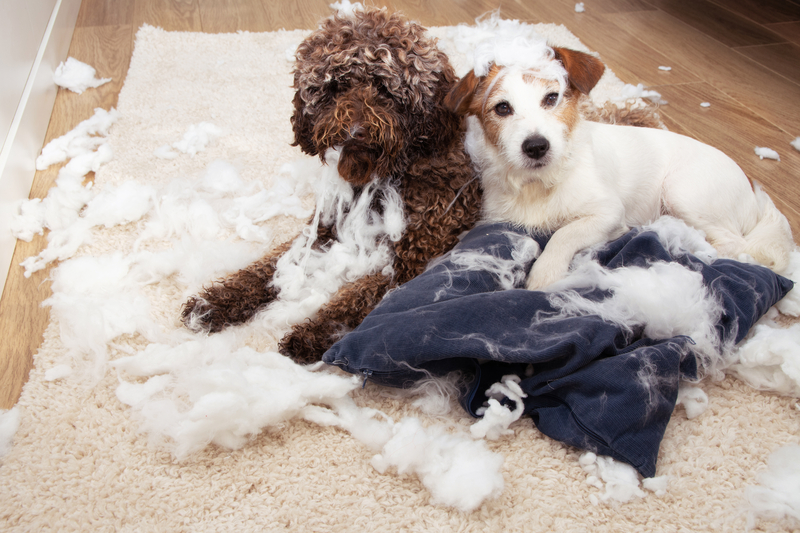How to Help Your Dogs & Puppies with Separation Anxiety
Separation anxiety in dogs and puppies is a serious issue that can cause significant distress for both pets and their owners. With work and social commitments that often take us away from home, many of our dogs struggle to cope with being left alone. This growing prevalence of separation anxiety demands our attention and action to ensure the well-being of our pets.
Separation anxiety in dogs is more than just a bit of whining when you leave the house; it’s a complex psychological issue that can profoundly affect a dog’s quality of life. When a dog cries when left alone, it’s not merely seeking attention—it’s experiencing genuine distress. By understanding the causes, recognising the signs, and implementing effective strategies, we can help our canine companions feel more secure and content during periods of separation.
What is Separation Anxiety in Dogs?
Separation anxiety in dogs is a behavioural disorder characterised by extreme distress when a dog is left alone or separated from their primary caregiver. It’s more than just a bit of whining or sulking; it’s a serious condition that can manifest in various emotional and physical symptoms.
This disorder is surprisingly common, affecting dogs of all breeds, ages, and backgrounds. It can strain the bond between pet and owner, leading to frustration and, in severe cases, even rehoming.
Why Do Dogs and Puppies Get Separation Anxiety?
Several factors can contribute to the development of separation anxiety in your dogs and puppies:
- Genetic predisposition: Some breeds may be more prone to anxiety disorders, including separation anxiety.
- Environmental Changes: Major life changes, such as a moving house or a shift in the owner’s work schedule, can trigger anxiety in dogs.
- Negative early experiences: Dogs who have experienced trauma, frequent rehoming, or inadequate socialisation as puppies may be more susceptible to separation anxiety.
- Attachment issues: While a strong bond between dog and owner is generally positive, over-dependence and lack of independence training can lead to anxiety when separated.
- Development Factors: The experiences a puppy has during critical developmental periods can significantly impact their ability to cope with separation later in life. The first 16 weeks of a puppy’s life are particularly crucial for socialisation and learning to be comfortable in various situations, including being alone.
Signs of Separation Anxiety
Recognising the signs of separation anxiety is the first step in helping your dog. Here are some common symptoms to watch out for:
- Clingy behaviour: Your dog may become excessively attached, following you from room to room and becoming distressed when you prepare to leave.
- Destructive actions: Dog anxiety signs and symptoms often include destructive behaviour when left alone, such as chewing furniture, scratching doors, or tearing up household items.
- Vocalisations: A dog cries when left alone, often exhibiting excessive barking, howling, or whining.
- House soiling: Even well-trained dogs may urinate or defecate indoors when experiencing separation anxiety.
- Restlessness: As you prepare to leave, your dog may become agitated, pacing or showing signs of distress.
- Self-harm: In severe cases, dogs may injure themselves in attempts to escape confinement or due to extreme stress.
- Separation anxiety in dogs at night time: Some dogs may exhibit these symptoms specifically when left alone at night, disrupting both their sleep and yours.
How to Help a Dog With Separation Anxiety
Addressing separation anxiety requires patience, consistency, and an all-rounded approach. Here are some strategies to help your anxious pup:
- Gradual desensitisation: Start by leaving your dog alone for very short periods, gradually increasing the duration as they become more comfortable. This helps your dog learn that your departure isn’t permanent and that you will return.
- Creating a safe space: Designate a comfortable area where your dog can relax when alone. This might be a specific room, a crate (if your dog is properly crate-trained), or a bed in a quiet corner.
- Downplay departures and arrivals: Make your comings and goings low-key to avoid heightening your dog’s emotional response.
- Positive reinforcement: Reward calm behaviour when you’re preparing to leave or when your dog is relaxed in their designated safe space.
- Teach independence: Encourage your dog to enjoy time alone by providing special toys or treats that are only available when you’re not present.
- Practice “stay” and “settle” commands: These can help your dog learn to remain calm and in one place, even as you move away.
- Physical exercise: Ensure your dog gets plenty of exercise before you leave, as a tired dog is more likely to rest when alone.
- Mental stimulation: Provide puzzle toys, treat-dispensing toys, or frozen Kongs for your dogs to play with. keep them dog-occupied and mentally engaged while you’re away.
- Background noise: Leave the radio or television on to provide comforting background noise and mask outside sounds that might trigger anxiety.
- Consistent schedule: Try to keep your dog’s feeding, walking, and alone times on a regular schedule to provide a sense of predictability.
- Departure cues: Change up your typical leaving routine to prevent your dog from becoming anxious as soon as they see you putting on your coat or picking up your keys.
- Calm departures and returns: Keep goodbyes brief and low-key. When you return, wait until your dog is calm before greeting them enthusiastically.
When to Seek Professional Help
While many cases of separation anxiety can be managed with home interventions, some situations require professional assistance. Consider seeking help if:
- Symptoms persist or worsen despite consistent training efforts.
- Your dog exhibits severe destructive behaviours or self-injury.
- You’re struggling to implement training techniques effectively.
Make Your Dogs and Puppies Feel Better with Hunter’s Lodge
Separation anxiety in dogs is a challenging but manageable condition. With patience, understanding, and the right strategies, you can help your furry friend feel more secure and content when left alone. Remember, every dog is unique, and what works for one may not work for another. Be prepared to try different approaches and adjust your strategies as needed.
At Hunter’s Lodge, we understand the challenges that separation anxiety can pose for both dogs and their owners. That’s why we offer a range of services designed to help your pet feel more comfortable and confident, even when you’re not around.
Our doggy daycare service provides an excellent opportunity for your dog to socialise, play, and burn off energy in a safe and supervised environment. With 9.5 acres of land to explore, your dog will have plenty of space to run, play, and interact with other dogs. This social interaction and physical activity at our doggy day-care can be incredibly beneficial for dogs struggling with separation anxiety, helping them to build confidence and independence.
For those times when you need to be away for longer periods, our luxury dog kennel services offer a home away from home for your pet. Our experienced staff ensure that each dog receives plenty of attention, exercise, and care, helping to ease the stress of being away from their owners.
For dogs who require extra attention or have specific needs, we also offer VIP dog rooms. These premium accommodations provide additional comfort and one-on-one care to ensure your dog feels as relaxed and content as possible during their stay.
To get a better idea of what we offer, why not explore our gallery? You’ll find plenty of photos showcasing our facilities, including our spacious play areas and comfortable kennels. Seeing these images can help both you and your dog feel more at ease about their time with us.
Contact us today to learn more about our services and how we can help your dog overcome separation anxiety. Our friendly staff are always happy to discuss your pet’s specific needs and how we can accommodate them.

